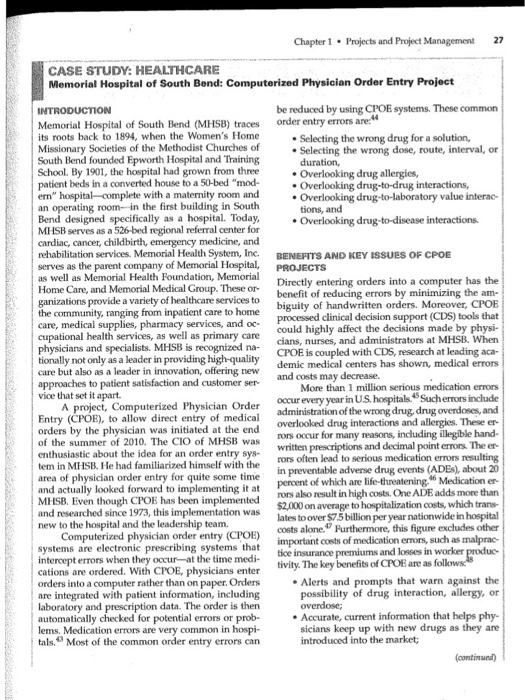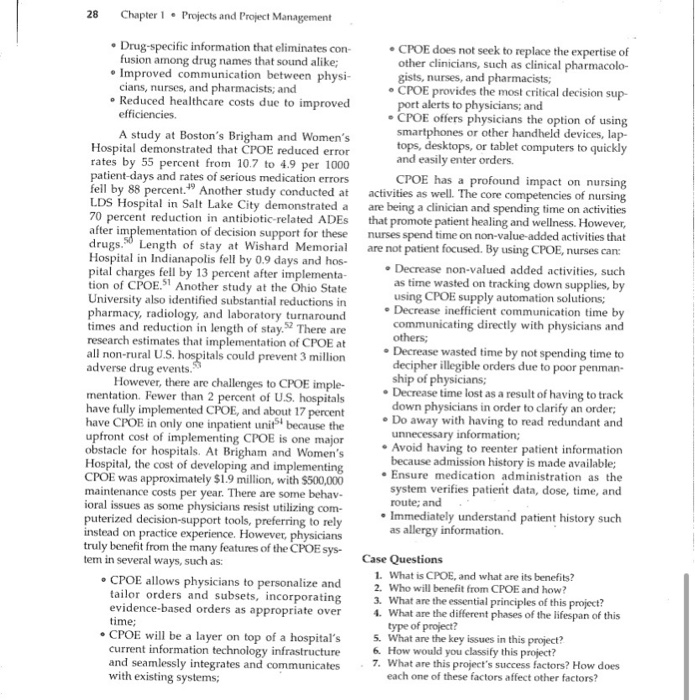Answered step by step
Verified Expert Solution
Question
1 Approved Answer
What are and explain the key project management aspects that were covered about PM life cycle, stakeholders, and scope in regards to this article? Chapter
What are and explain the key project management aspects that were covered about PM life cycle, stakeholders, and scope in regards to this article? 

Chapter 1 . Projects and Project Management 27 CASE STUDY: HEALTHCARE Memorial Hospital of South Bend: Computerized Physician Order Entry Project be reduced by using CPOE systems. These common order entry errors are: Selecting the wrong drug for a solution, Selecting the wrong dose, route, interval, or duration, Overlooking drug allergies, Overlooking drug-to-drug interactions, Overlooking drug-to-laboratory value interac- tions, and Overlooking drug-to-disease interactions. INTRODUCTION Memorial Hospital of South Bend (MHSB) traces its roots back to 1894, when the Women's Home Missionary Societies of the Methodist Churches of South Bend founded Epworth Hospital and Training School. By 1901, the hospital had grown from three patient beds in a converted house to a 50-bed "mod- ern" hospital complete with a maternity room and an operating room in the first building in South Bend designed specifically as a hospital. Today, MHSB serves as a 526-bed regional referral center for cardiac, cancer, childbirth, emergency medicine, and rehabilitation services. Memorial Health System, Inc. serves as the parent company of Memorial Hospital, as well as Memorial Health Foundation, Memorial Home Care, and Memorial Medical Group. These or ganizations provide a variety of healthcare services to the community, ranging from inpatient care to home care, medical supplies, pharmacy services, and oc- cupational health services, as well as primary care physicians and specialists. MHSB is recognized na- tionally not only as a leader in providing high-quality care but also as a leader in innovation, offering new approaches to patient satisfaction and customer ser vice that set it apart. A project, Computerized Physician Order Entry (CPOE), to allow direct entry of medical orders by the physician was initiated at the end of the summer of 2010. The CIO of MHSB was enthusiastic about the idea for an order entry sys- tem in MHSB. He had familiarized himself with the area of physician order entry for quite some time and actually looked forward to implementing it at MHSB. Even though CPOE has been implemented and researched since 1973, this implementation was new to the hospital and the leadership team. Computerized physician order entry (CPOE) systems are electronic prescribing systems that intercept errors when they occur-at the time medi- cations are ordered. With CPOE, physicians enter orders into a computer rather than on paper. Orders are integrated with patient information, including laboratory and prescription data. The order is then automatically checked for potential errors or prob- lems. Medication errors are very common in hospi- tals. Most of the common order entry errors can BENEFITS AND KEY ISSUES OF CPOE PROJECTS Directly entering orders into a computer has the benefit of reducing errors by minimizing the am- biguity of handwritten orders. Moreover, CPOE processed clinical decision support (CDS) tools that could highly affect the decisions made by physi- cians, nurses, and administrators at MHSB. When CPOE is coupled with CDS, research at leading aca- demic medical centers has shown, medical errors and costs may decrease. More than 1 million serious medication errors occur every year in U.S. hospitals. Such errors include administration of the wrong drug drug overdoses, and overlooked drug interactions and allergies. These er rors occur for many reasons, including illegible hand- written prescriptions and decimal point errors. The er rors often lead to serious medication errors resulting in preventable adverse drug events (ADE), about 20 percent of which are life-threatening Medication er rors also result in high costs. One ADE adds more than $2,000 on average to hospitalization costs, which trans- lates to over $7.5 billion per year nationwide in hospital costs alone. Furthermore, this figure excludes other important costs of medication errors, such as malprac tice insurance premiums and losses in worker produc tivity. The key benefits of CPOE are as follows. Alerts and prompts that warn against the possibility of drug interaction, allergy, or overdose; Accurate, current information that helps phy- sicians keep up with new drugs as they are introduced into the market: (continual) Chapter 1 Projects and Project Management Drug-specific information that eliminates con- fusion among drug names that sound alike; Improved communication between physi- cians, nurses, and pharmacists, and Reduced healthcare costs due to improved efficiencies. A study at Boston's Brigham and Women's Hospital demonstrated that CPOE reduced error rates by 55 percent from 10.7 to 4.9 per 1000 patient-days and rates of serious medication errors fell by 88 percent." Another study conducted at LDS Hospital in Salt Lake City demonstrated a 70 percent reduction in antibiotic-related ADES after implementation of decision support for these drugs. Length of stay at Wishard Memorial Hospital in Indianapolis fell by 0.9 days and hos- pital charges fell by 13 percent after implementa- tion of CPOE. Another study at the Ohio State University also identified substantial reductions in pharmacy, radiology, and laboratory turnaround times and reduction in length of stay. There are research estimates that implementation of CPOE at all non-rural U.S. hospitals could prevent 3 million adverse drug events. However, there are challenges to CPOE imple- mentation. Fewer than 2 percent of U.S. hospitals have fully implemented CPOE, and about 17 percent have CPOE in only one inpatient unit because the upfront cost of implementing CPOE is one major obstacle for hospitals. At Brigham and Women's Hospital, the cost of developing and implementing CPOE was approximately $1.9 million, with $500,000 maintenance costs per year. There are some behav- ioral issues as some physicians resist utilizing com- puterized decision-support tools, preferring to rely instead on practice experience. However, physicians truly benefit from the many features of the CPOE sys- tem in several ways, such as: CPOE allows physicians to personalize and tailor orders and subsets, incorporating evidence-based orders as appropriate over time: CPOE will be a layer on top of a hospital's current information technology infrastructure and seamlessly integrates and communicates with existing systems, CPOE does not seek to replace the expertise of other clinicians, such as clinical pharmacolo- gists, nurses, and pharmacists; CPOE provides the most critical decision sup- port alerts to physicians; and CPOE offers physicians the option of using smartphones or other handheld devices, lap- tops, desktops, or tablet computers to quickly and easily enter orders. CPOE has a profound impact on nursing activities as well. The core competencies of nursing are being a clinician and spending time on activities that promote patient healing and wellness. However, nurses spend time on non-value-added activities that are not patient focused. By using CPOE, nurses can: Decrease non-valued added activities, such as time wasted on tracking down supplies, by using CPOE supply automation solutions; Decrease inefficient communication time by communicating directly with physicians and others; Decrease wasted time by not spending time to decipher illegible orders due to poor penman- ship of physicians; Decrease time lost as a result of having to track down physicians in order to clarify an order; Do away with having to read redundant and unnecessary information; Avoid having to reenter patient information because admission history is made available; Ensure medication administration as the system verifies patient data, dose, time, and route; and Immediately understand patient history such as allergy information. Case Questions 1. What is CPOE, and what are its benefits? 2. Who will benefit from CPOE and how? 3. What are the essential principles of this project? 4. What are the different phases of the lifespan of this type of project? 5. What are the key issues in this project? 6. How would you classify this project? 7. What are this project's success factors? How does each one of these factors affect other factors 

Step by Step Solution
There are 3 Steps involved in it
Step: 1

Get Instant Access to Expert-Tailored Solutions
See step-by-step solutions with expert insights and AI powered tools for academic success
Step: 2

Step: 3

Ace Your Homework with AI
Get the answers you need in no time with our AI-driven, step-by-step assistance
Get Started


